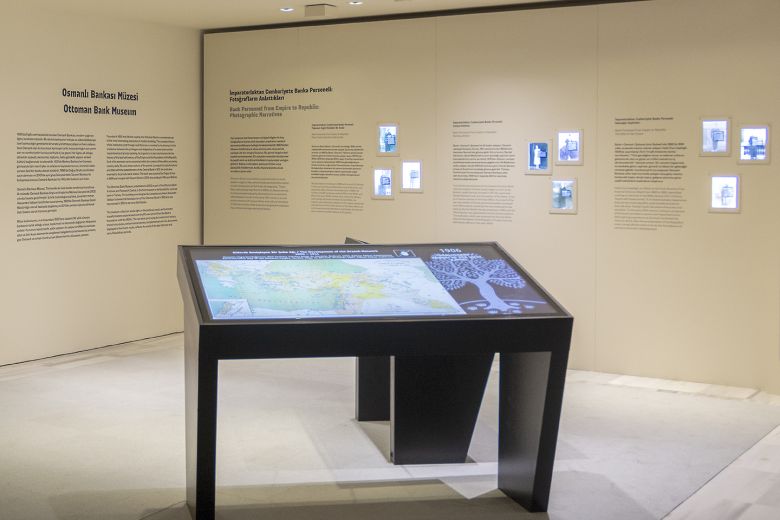Ottoman Bank Museum
Salt Galata

Fotoğraf: Mustafa Hazneci, May 2023
Ottoman Bank Museum (OBM) spreads throughout the floors of Salt Galata, the bank’s headquarters between 1892 and 1999.
The Ottoman Bank Museum is the first museum to be founded by a private bank in Turkey. Established in 2002 as part of the Ottoman Bank Archives and Research Centre, the museum is currently organized in the bank vaults and on the floors of the building.
The museum sheds light on the history of the Ottoman Bank, formerly the central bank and treasurer of the Ottoman Empire. The objects and documents in the collection, as well as the design of the museum itself, reflect the world of the late Ottoman and early Republican periods. The museum chronologically highlights the significant changes, developments, and crises experienced over the 80-year period from the Bank’s founding until 1933, when it gained private bank status. Particular focus is given to the branch buildings, customers, and areas of activity of the same period. A selection of documents, photographs, architectural drawings, illustrations, and newspaper clippings from the collection showcases both the Bank’s history and the social panorama of the period.
The foundation and transformation of the bank, the development of the branch network, and personnel stories are portrayed on floor -1, while the construction of the head office building is presented on the ground floor. These interactive presentations are accompanied by physical archival materials such as banknotes, journals, shares, and personnel photographs in addition to customer and personnel files in the vaults at Salt Research Ferit F. Şahenk Hall.
Archival work and conceptual development: Edhem Eldem
Design: Bülent Erkmen
Design implementation of display units in bank vaults: Yeşim Bakırküre ve Ypsilon
Design and implementation of interactive presentations: Atay İlgün
Design and implementation of exhibition units: Emirhan Altuner
About the Ottoman Bank
Ottoman Bank was established in Istanbul by British entrepreneurs Peter Pasquali and Stephen Sleigh with Queen Victoria’s charter dated May 24, 1856. With the aim of entering the developing commercial banking sector of the Ottoman Empire, the bank opened in Saint Pierre Han in Galata with around twenty officers. The institution was elevated to the status of a state bank and was renamed the Imperial Ottoman Bank with a decree from Sultan Abdülaziz on February 4, 1863. The branch network gradually expanded and spread throughout the Empire from Tripoli and Benghazi in Libya to Hodeidah in the Hejaz and Basra in Southern Iraq. Losing all its state functions and titles with the establishment of the Central Bank, the institution reverted to its private bank status in 1933. It was acquired by Doğuş Group in 1996 and merged with Garanti Bank in 2001, thus officially terminating its activities.
The online presentations, detailing the Bank’s 145-year history through archival documents from the Museum’s collection, can be accessed via Google Arts & Culture. Click here to view.
The Ottoman Bank Museum is the first museum to be founded by a private bank in Turkey. Established in 2002 as part of the Ottoman Bank Archives and Research Centre, the museum is currently organized in the bank vaults and on the floors of the building.
The museum sheds light on the history of the Ottoman Bank, formerly the central bank and treasurer of the Ottoman Empire. The objects and documents in the collection, as well as the design of the museum itself, reflect the world of the late Ottoman and early Republican periods. The museum chronologically highlights the significant changes, developments, and crises experienced over the 80-year period from the Bank’s founding until 1933, when it gained private bank status. Particular focus is given to the branch buildings, customers, and areas of activity of the same period. A selection of documents, photographs, architectural drawings, illustrations, and newspaper clippings from the collection showcases both the Bank’s history and the social panorama of the period.
The foundation and transformation of the bank, the development of the branch network, and personnel stories are portrayed on floor -1, while the construction of the head office building is presented on the ground floor. These interactive presentations are accompanied by physical archival materials such as banknotes, journals, shares, and personnel photographs in addition to customer and personnel files in the vaults at Salt Research Ferit F. Şahenk Hall.
Archival work and conceptual development: Edhem Eldem
Design: Bülent Erkmen
Design implementation of display units in bank vaults: Yeşim Bakırküre ve Ypsilon
Design and implementation of interactive presentations: Atay İlgün
Design and implementation of exhibition units: Emirhan Altuner
About the Ottoman Bank
Ottoman Bank was established in Istanbul by British entrepreneurs Peter Pasquali and Stephen Sleigh with Queen Victoria’s charter dated May 24, 1856. With the aim of entering the developing commercial banking sector of the Ottoman Empire, the bank opened in Saint Pierre Han in Galata with around twenty officers. The institution was elevated to the status of a state bank and was renamed the Imperial Ottoman Bank with a decree from Sultan Abdülaziz on February 4, 1863. The branch network gradually expanded and spread throughout the Empire from Tripoli and Benghazi in Libya to Hodeidah in the Hejaz and Basra in Southern Iraq. Losing all its state functions and titles with the establishment of the Central Bank, the institution reverted to its private bank status in 1933. It was acquired by Doğuş Group in 1996 and merged with Garanti Bank in 2001, thus officially terminating its activities.
The online presentations, detailing the Bank’s 145-year history through archival documents from the Museum’s collection, can be accessed via Google Arts & Culture. Click here to view.

